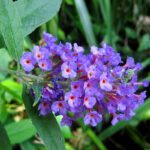bearded iris
Bearded irises are so care free that one sees them growing on the side of the road sometimes. They also thrive in cemeteries, their funeral association making some people uncomfortable, despite their beautiful countenance. The ancient Greeks named the plant after the goddess Iris, guardian of the rainbow and one of gods’ messengers. They thought that planting these flowers on graves would guide the souls of loved ones into the next life. Somber trivia aside, irises are extremely versatile plants and put up a superb display, even if only for a short month. The spent flowers don’t look too hot, so don’t forget to promptly deadhead the plants after blooming to keep the garden tidy.
The iris rhizome, also called orris root, is a basic perfumery ingredient because it locks in fragrances and makes them last longer. Interestingly enough, the classic French symbol, the fleur-de-lys is actually depicting the iris and not the lily.
Irises can be grown pretty much everywhere in the US, and many of them are pleasantly fragrant. They come in shades of lavender or purple, pure blue, yellow, pale pink, white, orange, and all combinations thereof. They make great cut flowers and are spectacular on a background of pale lavender creeping phlox or among pink roses.
If they find a good location with clay soil, enough water and sunlight they will spread quickly and create large clumps. You can divide them at the end of summer by digging out the root and breaking it up into 2 to 4 inch sections, making sure that every segment has a clump of leaves attached.
These cobalt blue beauties are very striking in their location, surrounded by white roses; they tend to pale towards a lavender blue as they fade.
For a perennial garden joy and vitality resides in changing with the seasons and breathing new colors, textures and fragrances as springs moves to summer and summer to fall. Next month the irises will fade and the snapdragons will take their place, and after that the cone flowers, and the stone crops: the garden alive.




 Previous Post
Previous Post Next Post
Next Post




